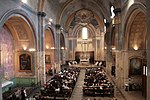Ancient Diocese of Orange
1801 disestablishments in FranceAccuracy disputes from April 2017All accuracy disputesFormer Roman Catholic dioceses in FranceVaucluse

The ancient residential diocese of Orange in the Comtat Venaissin in Provence, a fief belonging to the papacy, was suppressed by the French government during the French Revolution. It was revived in 2009 as a titular see of the Catholic Church.
Excerpt from the Wikipedia article Ancient Diocese of Orange (License: CC BY-SA 3.0, Authors, Images).Ancient Diocese of Orange
Rue de la Renaissance, Carpentras
Geographical coordinates (GPS) Address Nearby Places Show on map
Geographical coordinates (GPS)
| Latitude | Longitude |
|---|---|
| N 44.14 ° | E 4.81 ° |
Address
Rue de la Renaissance 37
84100 Carpentras, Baron
Provence-Alpes-Côte d'Azur, France
Open on Google Maps










